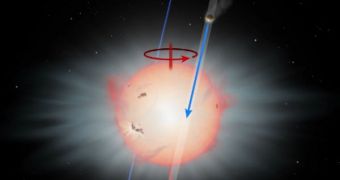In a new large-scale study they conducted on a number of exoplanetary systems, astronomers in Japan discovered that inclined orbits may be the rule rather than the exception for planets orbiting other stars than our own Sun.
In other words, it could that our solar system is the exception to the rule and not the other way around. The research was conducted by experts at the National Astronomical Observatory of Japan (NAOJ), who collaborated with colleagues from the University of Tokyo.
Experts found out in previous studies that exoplanets tend to move around their parent stars in highly-inclined orbits. These are calculated by looking at the differences between the angle of the stellar rotational axis and the angle of the planetary orbital axis.
Studies the Japanese team conducted on exoplanets HAT-P-11b and XO-4b demonstrate that both systems orbit their parent stars in highly-inclined orbits. The former is also a very small planet, and this is the first time such a study was conducted for such a tiny object.
One of the most important set of implications that the new work has relates to testing a large number of astronomical models, that seek to explain how is it that these exoplanetary systems came to exist in their current configuration.
Another thing that is apparently characteristic to many star systems is the planets within orbiting their parent star at very close distance, regardless of their sizes, Universe Today reports.
In our solar system, the gas giants Jupiter, Saturn, Neptune and Uranus orbit relatively far away from the Sun, whereas the smaller, rocky worlds orbit closer. In other systems, the situation would be reversed.
Also, a huge array of processes appear to be taking place around other stars, that do not happen here. One example is hot Jupiter-class planets being drawn so close to their stars that they become tidally locked, and are eventually consumed.
There is currently a very large number of theories and ideas seeking to explain why this planetary migration occurs, but in truth there are very small chances that we will be able to figure this out without any direct observations.
However, in the effort to establish which theory is worth pursuing, determining why the exoplanets are so inclined in regards to their parent stars' rotational axis is very important. Migration models can either be confirmed or refuted by such studies.

 14 DAY TRIAL //
14 DAY TRIAL //